Patagonia SnowDrifter Jacket
Reviewer: 5’10”, 145 lbs
Size Tested: Medium
Blister’s Measured Weight (size Medium): 615 grams
Fabric: 3-layer H2No Standard Performance Shell w/ 5-oz, 75-denier 100% polyester (70% recycled) stretch ripstop face fabric with a DWR finish and soft knit backer
Stated Features:
- Light and stretchy 3L fabric and minimalist design allow for full range of movement, with added protection, breathability and a moisture-managing knit backer
- Helmet-compatible, two-way-adjustable fixed hood with laminated visor for optimal visibility in bad conditions. Cohaesive embedded cord-lock system in hood and hem provides quick and easy adjustment
- Pit zips quickly release heat
- Adjustable, low-profile cuffs secure over or under gloves
- Adjustable powder skirt can be cinched for a tight seal or lies flat when not in use; webbing loop at center back connects to any Patagonia Snow pants
- Concealed RECCO reflector
Pockets:
- 2 exterior hand pockets (zippered)
- 1 exterior chest pocket (zippered)
- 1 exterior bicep pocket (zippered)
- 1 interior drop-in pocket
- 1 interior chest pocket (zippered)
MSRP: $399
Test Locations: Crested Butte, Telluride, Summit County, & Front Range; CO
Days Tested: ~10
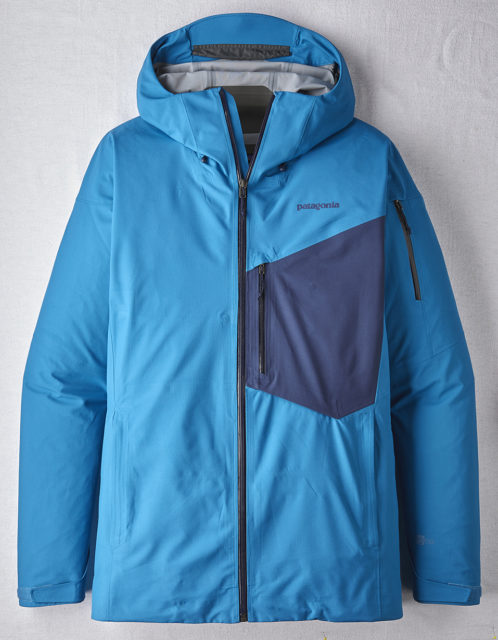
Intro
For the 19/20 winter season, Patagonia is replacing their Descensionsist jacket and pants with a new kit called the SnowDrifter. We were big fans of the Descensionist kit here at Blister, so the SnowDrifter certainly has a lot to live up to.
As with any product that replaces one that we loved, we were very curious about the SnowDrifter kit. We discussed the SnowDrifter kit on our GEAR:30 podcast, talked with Patagonia’s senior material developer about its new fabric, and published a review of the SnowDrifter Bibs.
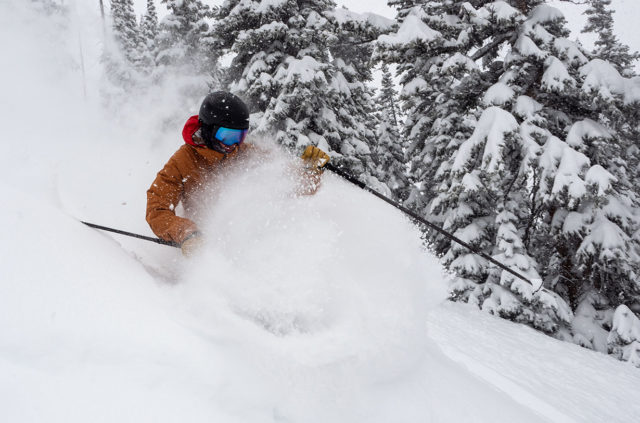
But now it’s finally time to dive into the SnowDrifter Jacket, how it compares to the Descensionist Jacket and other shells on the market, and who we think would like it most (spoiler alert: it’s probably a lot of people).
Fit
Similar to the SnowDrifter Bib, the SnowDrifter jacket has more of a relaxed, “freeride” cut. It is a bit roomier all around than the Descensionist Jacket but not quite as baggy as some heavier and more inbounds-oriented shells like The North Face Ceptor and Open Wear Open One 3L Shell.
The SnowDrifter’s sleeves are generously cut and fall at my second knuckle with my arms at my side (I’m 5’10”, 145 lbs and wore a size Medium). The hem hits me about 2-3” above mid-thigh and the torso has plenty of room underneath for extra layers. Overall, I think the SnowDrifter’s fit is just nice. It looks natural and the jacket drapes quite well. It isn’t too baggy so that you look like a park rat and it isn’t a super-slim touring fit, either. It just feels good.
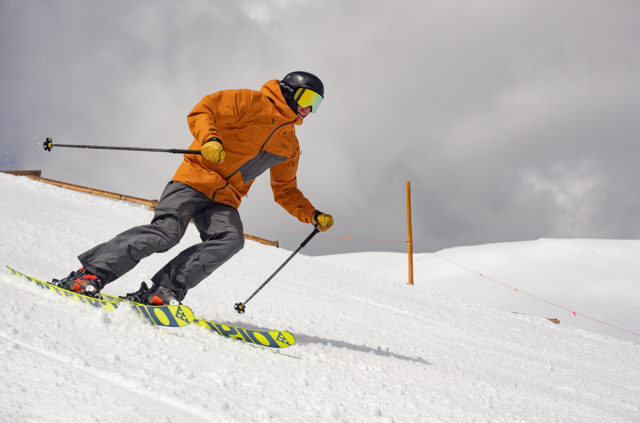
One of my few gripes with the SnowDrifter jacket does pertain to fit, though. And particularly, its collar. The collar of the SnowDrifter Jacket is pretty standard in terms of height and size, if not slightly large. It isn’t’ as big as the gargantuan collar on the North Face Ceptor or the very large collar on the Black Diamond Mission Shell, but it certainly isn’t small.
While I haven’t had any issues with the large collars on the Ceptor and Mission jackets, the Snowdrifter’s is a bit different. When I have the SnowDrifter Jacket zipped all the way up — and especially when I’m skiing fast inbounds — the collar can get quite tight and uncomfortable on my neck. This is easily alleviated by unzipping the top 4-6” of the collar, but it has been a consistent annoyance when testing this spring.
I think there are two things that I think contribute to this: (1) the supple drape of the SnowDrifter’s fabric and (2) the fact that I’ve primarily been testing it in the spring with minimal layering underneath.
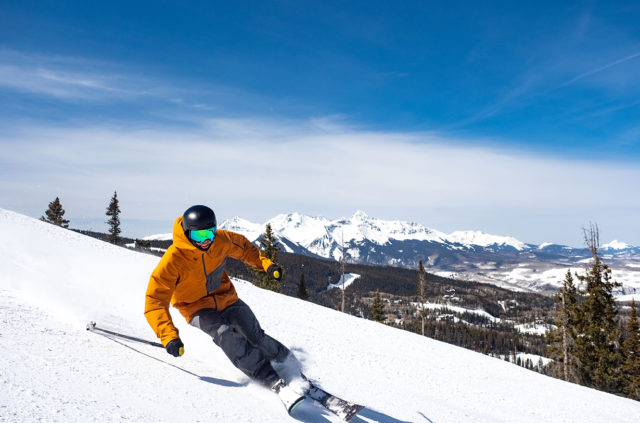
The fabric on the SnowDrifter kit is extremely soft in the hand and very supple. It drapes easily and is crazy comfortable for a hard shell. But when skiing fast, I think the wind catches the hood a bit and, because the fabric is so soft and easy to manipulate, it easily pulls the collar up against my neck. And because I don’t have many layers on my upper body or neck during warm spring days, there isn’t much resistance to keep the collar in place.
This is a pretty minor complaint in the grand scheme of things, and was alleviated when I had thicker mid layers under the jacket by just unzipping the main zipper a few inches.
Features
The SnowDrifter Jacket is surprisingly fully featured given its reasonably low weight (many of the lighter jackets we’ve tested are minimal touring shells). The SnowDrifter Jacket has 6 pockets, a 3-way adjustable hood, powder skirt, and pit zips (which are 14.5” long).
The SnowDrifter Jacket’s pockets are all quite logical and work well. The hand pockets are well placed and comfortable to use, the chest pocket is quite large and bellows out to accommodate larger loads — though none of these pockets are quite big enough for an average-sized climbing skin. The bicep pocket is quite small and only large enough for a pass and / or a lipbalm.
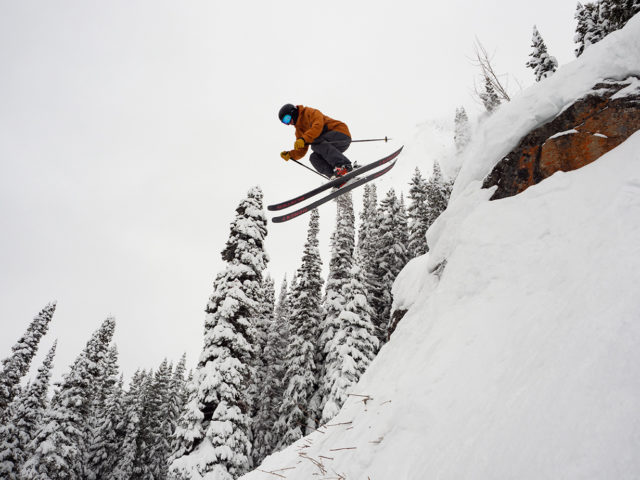
The SnowDrifter’s interior pockets are fairly small. The drop-in pocket is large enough to fit a pair of goggles snuggly and the zip pocket is big enough for a large phone.
The SnowDrifter’s hood uses what seems to be becoming the industry standard for adjustment — two embedded / concealed cord locks on either side of the collar and one at the back. There’s a reason this system is so common — it works well. The hood has a relatively stiff brim and the hood can fit over all of my helmets and also be comfortably cinched down over a bare or beanie-clad head.
The SnowDrifter Jacket’s powder skirt is pretty minimal and does not detach. It has a wide range of adjustment and, after using it on one of the biggest powder days of the year at Crested Butte, I can confidently say that it gets the job done when it comes to keeping out snow.
Lastly, the SnowDrifter Jacket’s 14.5” pit zips are pretty standard — two-way zipper pulls with reverse-coil laminated zippers. They work as expected, with nothing out of the ordinary to report.
Weight
The SnowDrifter Jacket joins a large group of fairly versatile jackets that come in right around 600 grams. The thing that sets this jacket apart in that weight class though is its soft fabric and full feature set — many of the lighter jackets on the market are not as comfortable and / or don’t have as many features. Packed down, the SnowDrifter Jacket is somewhere between the size of a grapefruit and a cantaloupe.
Here a list of similar jackets and their weights. Note that not all of the jackets are the same size, so try to keep that in mind when making comparisons.
364 g Black Diamond Helio Active Shell, size Medium
366 g Patagonia Ascensionist Jacket, size Medium
518 g Flylow Cooper Jacket, size Medium
544 g Outdoor Research Hemispheres Jacket, size Medium
563 g Rab Sharp Edge Jacket, size Medium
574 g Amundsen Peak Anorak, size Medium
590 g Flylow Higgins Coat 2.1, size Large
593 g Patagonia PowSlayer Jacket, size Large
605 g Patagonia Descensionist Jacket, size Medium
610 g Strafe Cham Jacket, size Large
615 g Patagonia SnowDrifter Jacket, size Medium
626 g Arc’teryx Sabre LT Jacket, size Medium
635 g Mammut Alvier Armor Hardshell Jacket, size Medium
726 g Holden M-51 Fishtail 3 Layer Jacket, size Medium
825 g The North Face Ceptor Jacket, size Medium
841 g Strafe Pyramid Jacket, size Large
848 g Open Wear Open One 3L Shell Jacket, size Medium
Materials
The SnowDrifter Jacket and Bibs use the same excellent shell fabric. Here’s what I said about the fabric on the Bibs:
“Patagonia’s new 3L H2No fabric used in the SnowDrifter is incredibly comfortable. It’s the main reason we all got extremely excited about the SnowDrifter at Outdoor Retailer this year — the hand feel on the fabric is incredible.
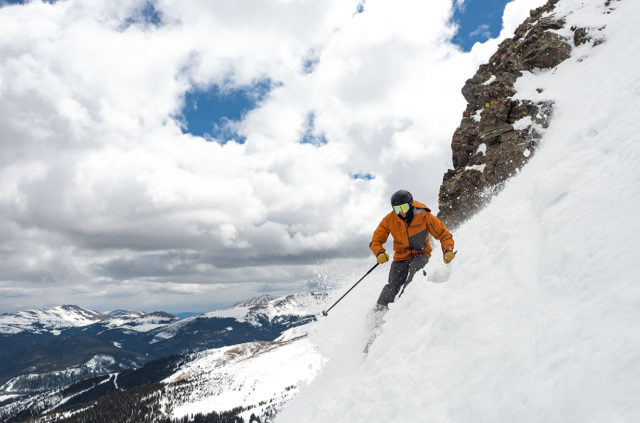
In use, the fabric is equally impressive as it was at the trade show. The SnowDrifter’s fabric has a fully protective 3L laminate, but it feels softer than even some of the softshells I’ve used. The SnowDrifter’s fabric is pretty stretchy and the liner material is very soft on the skin.
With the exception of the freakishly soft Rab Kinetic Plus (which Rab markets as a softshell, but that has a 10K-rated membrane), the SnowDrifter has the softest and most comfortable fabric of any waterproof shell I’ve used.
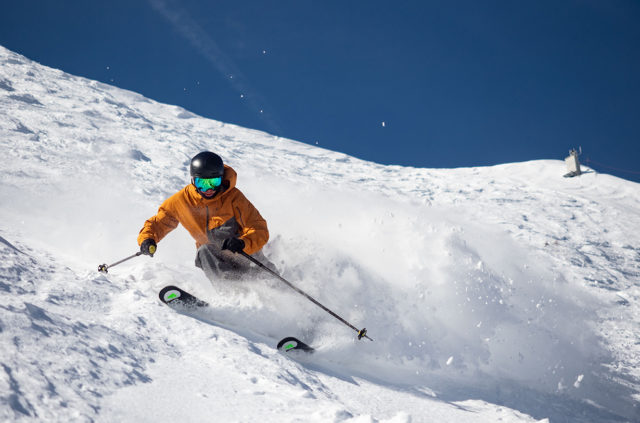
The Snowdrifter’s fabric has also proven to be quite hard wearing, especially given how soft it feels. After about 10 days in the jacket and bibs, there are certainly scuffs and scratches on the main fabric from ski edges, but in general, I’m very happy with how the kit is holding up.”
All of the same holds for the SnowDrifter Jacket. I’ve been extremely happy with this fabric in the jacket and, without the constant threat of ski edges at the cuffs, the jacket is holding up better than the bibs — it looks brand new.
Weather Resistance
Though Patagonia doesn’t publish waterproof / breathability ratings (which can be misleading and / or unreliable), we’ve been told that the SnowDrifter’s fabric is spec’d somewhere around 20K/20K — which would place it firmly in the “hardshell” category of protection (as opposed to less protective softshells).
In my experience with the SnowDrifter Jacket, I would say that it offers true hardshell performance when it comes to weather resistance. After using the jacket in several wet spring storms, I haven’t experienced any moisture soaking through the membrane.
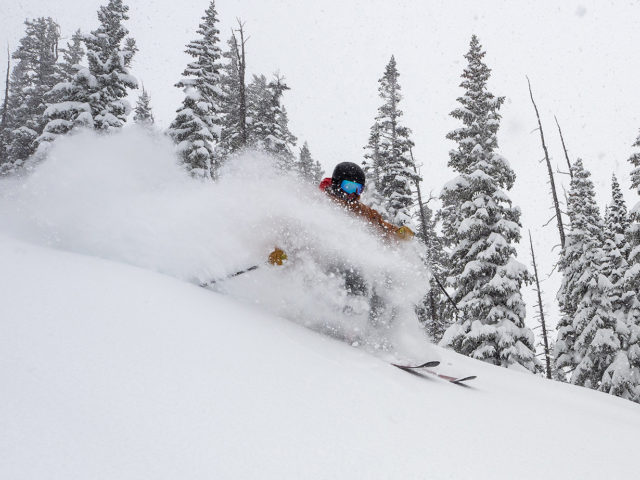
As seems to be the case with most shells that use soft face fabrics, I have experienced a bit more wetting out of the face fabric than I would expect on stiffer hardshell fabrics with tighter weaves. But I still haven’t had any water get all the way through the fabric of the SnowDrifter.
It’s also important to note that the pre-production SnowDrifter Jacket that I’ve been using featured an experimental DWR. The production version of the SnowDrifter kit will use Patagonia’s standard DWR treatment which has performed excellently on other pieces we’ve used from them. Apart from the DWR, everything else on the SnowDrifter kit we’ve been testing is the same as the production version that will be available this fall.
Breathability
One of the most notable differences between the Descensionist and the SnowDrifter is the breathability of the two fabrics. The SnowDrifter is significantly more protective than the Descensionist and, probably consequentially, significantly less breathable.
The Descensionist used one of the most breathable 3L fabrics we’ve ever tested. It was so breathable that it felt distinctly colder than more traditional hardshells, particularly in the wind. The SnowDrifter feels much more like most other hardshells when it comes to breathability and I’ve found it to be generally more comfortable in terms of temperature regulation — especially in the resort where my output is lower and I sweat much less.
The SnowDrifter Jacket wouldn’t be my top pick for touring, but this isn’t primarily due to the breathability. I rarely wear hardshells in the backcountry so I usually throw something very light and minimal into my packs. The SnowDrifter Jacket doesn’t pack down very small and is heavy by comparison to the hardshells I usually take on the skin track (the Black Diamond Helio or Patagonia Ascensionist).
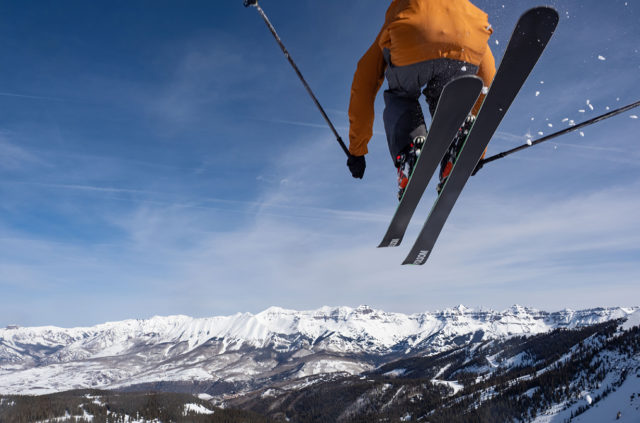
But as a one-jacket quiver, I think the SnowDrifter would be fine in higher-output situations like skinning or booting uphill. It will be a bit bulkier, heavier, and less breathable than other more dedicated backcountry shells (e.g., Helio & Ascensionist), but I would take the SnowDrifter Jacket over most other hardshells in this weight class for backcountry use.
All in all, the breathability of the SnowDrifter kit is good compared to other high-end, 3L waterproof / breathable shells. It doesn’t stand out as much as the Descensionist did in this regard, but for people who thought the Descensionist was too cold or not protective enough, the SnowDrifter is worth a good look.
Warmth
The SnowDrifter is a 3L hardshell with no added insulation. It is not a very warm jacket. In the category of hardshell jackets though, the SnowDrifter is one of the warmer ones I’ve worn. It isn’t so much warmer that I change my layering scheme compared to other hardshells, but the thicker, softer face fabric does seem to trap a bit more heat.
The SnowDrifter is significantly warmer than the Descensionist that it replaces, but you’ll still want to add layers under / over it in cold weather (like every other uninsulated hard shell).
Durability
After about 10 days in the SnowDrifter jacket, it looks practically brand new. I don’t expect the soft face fabric to hold up quite as well as heavier, stiffer fabrics we see on inbounds-oriented shells like the Flylow Baker Bib, Black Diamond Mission, or North Face Ceptor but I have been very happy with its durability so far. As always, we’ll update this review if we notice any issues down the line.
Who’s It For?
If you’re looking for a ski shell to be used mostly for inbounds days and prioritize comfort over maximum breathability or durability, then the SnowDrifter Jacket definitely deserves a look. This is easy to recommend to a lot of skiers.
If you’re spending the majority of your time on the skin track, I think you’d be better off in a lighter, more breathable shell like the Black Diamond Helio or Patagonia Ascensionist. Alternatively, if you spend all of your time riding lifts and value durability over all else, there are heavier, harder-wearing options (e.g., North Face Ceptor or Black Diamond Mission). But the SnowDrifter does a great job as a 50/50 jacket or an extremely comfortable resort jacket. And it’s even more appealing for this last category as it comes in at a pretty moderate price point of $399.
A lot of people are now getting into touring but are not spending 100% of their time in the backcountry, and the SnowDrifter Jacket seems like it’d work for a very wide range of skiers and snowboarders in that category.
Bottom Line
Like the SnowDrifter Bibs, the Patagonia SnowDrifter Jacket is an excellent addition to the ski / snowboard shell market. The new SnowDrifter Jacket arguably better serves a larger audience than the Descensionist it replaced, given that the SnowDrifter offers a more protective fabric, more versatile fit, and a surprisingly expansive feature set. I think a lot of people will get along quite well with the SnowDrifter Jacket.

Hi Sam,
can you compare the snowdrifter kit with the powslayer kit?
thanks,
Pietro
Hey Pietror, although I haven’t personally used the PowSlayer kit, the biggest differences should come down to fabric. The Gore Pro fabric used on the PowSlayer is going to be a bit more protective and more hardwearing. It has a more crinkly hand feel, doesn’t offer much (if any) stretch, and should breath better than the SnowDrifter too. The PowSlayer is also going to be cut a bit looser.
Hope that helps!
Sam
Sam
Any thoughts on pros and cons of the SnowDrifter vs the Strafe pyramid for 100% inbounds (with hike-to terrain) use.
The Pyramid will breathe better (it uses an air permeable NeoShell membrane) but as a consequence, won’t be quite as protective. The Pyramid is a bit heavier too. Although I don’t have them side-by-side here, I remember the Pyramid being cut a bit looser as well.
In general, for an inbounds jacket, I think the decision comes down to fit, aesthetics, and location. Pick the jacket that you like the look and fit of best. If you live in a wetter climate, I would lean towards the SnowDrifter in general and if you’re in a drier climate, both jackets should work just fine.
Hi, great review I love that you actually have several people on your team trying gear out.
I’m looking at this jacket (SnowDrifter) vs the Patagonia Powder Bowl. They come in at the same price and a very similar feature set, but different materials.
Snowdrifter is made with “3-layer, 5-oz 75-denier solid stretch ripstop H2No, soft polyester knit backer.”
Powder Bowl – “2-layer, 4.6-oz 150-denier GORE-TEX; (torso) 3.8-oz 100% brushed-polyester mesh; (sleeves) 3.8-oz 100% polyester mesh.”
Any input on how these might compare? My uneducated interpretation is that the Snowdrifter is a higher tier (3 vs 2 layer) of a less flashy/brand name material, but does 150 denier mean it’s much more hard wearing and would last longer?
Glad to hear you found the review useful! And I think you’re on the right track — the main differences come down to the two jackets’ fabrics. The Powder Bowl is a heavier, burlier, more inbounds-oriented 2-layer shell that will likely be more durable but its fabric is a bit stiffer and more similar to traditional hardshell jackets. The Snowdrifter is lighter and has a much more supple fabric (feels similar to most softshells), but probably won’t be quite as durable in the long run (though we haven’t had any issues with it so far). And if we had to venture a guess, we’re pretty confident that the Snowdrifter will feel a bit more breathable and comfortable in warmer temps. So I think the Powder Bowl makes more sense if you prioritize durability, while the Snowdrifter makes more sense if you prioritize comfort or want to use this jacket for touring.